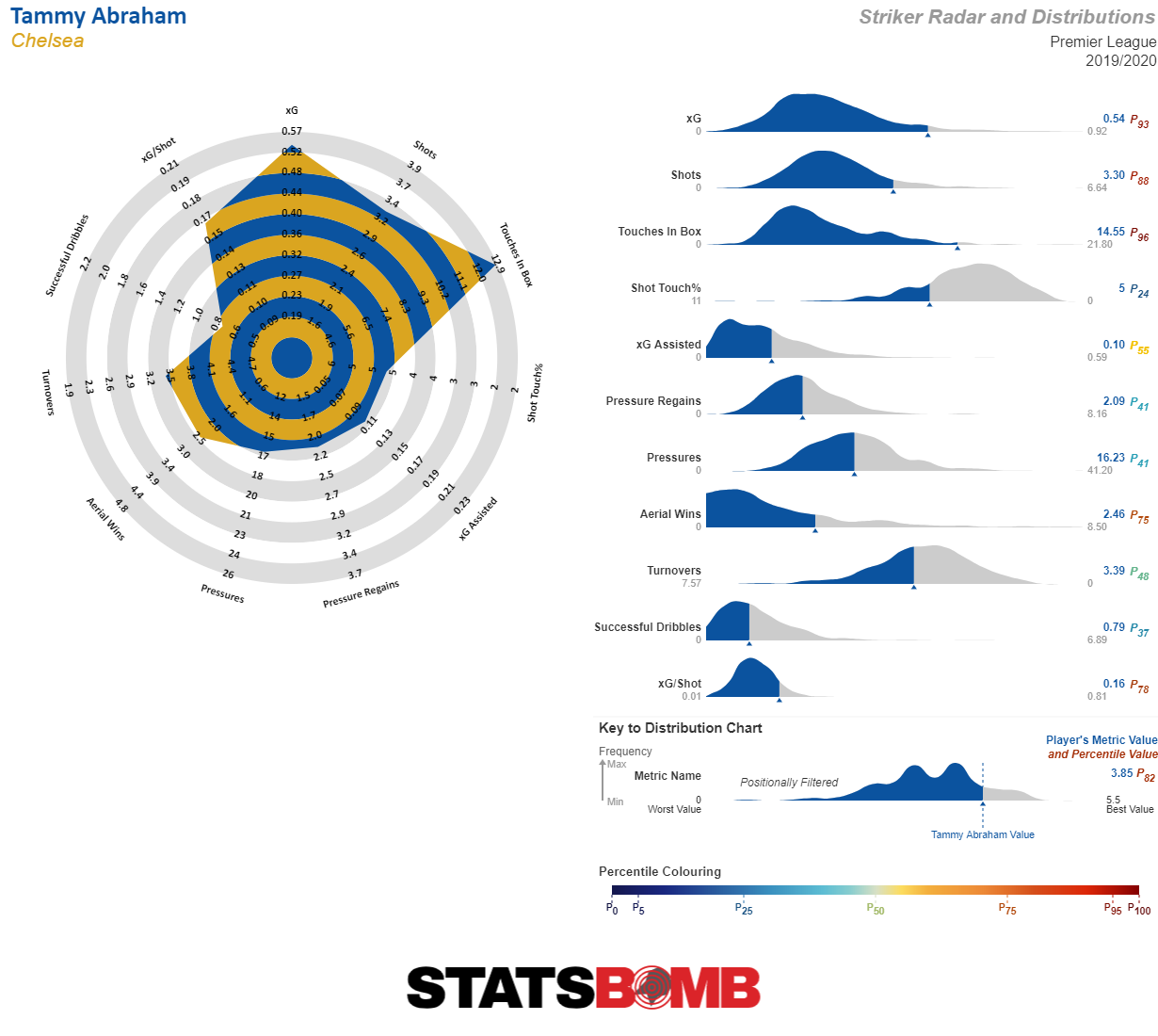When Schalke edged Mainz on matchday five, thanks to Amine Harit’s excellent outside of the boot winner, they had made it three wins in a row and people in German football began to take notice. That sort of streak is not exactly what Schalke fans are used to. They won six in a row in the spring of Domenico Tedesco’s miraculous second place season. The Royal Blues also had just two two game winning “streaks” in a dismal last season that saw them gain 33 points from 34 matches. Even more impressively, they followed up that Mainz result with a 2-1 victory over then league leaders RB Leipzig. It was Schalke’s first win against a team in the top spot in 14 tries and now they are the talk of Germany. You see, Ruhrpott giants and one of the Bundesliga’s best-supported clubs, Schalke are a team of extremes, with little room for anything in-between. 
Addition by squad subtraction
Schalke are now on their fourth permanent head coach in five seasons, David Wagner, the German-born American/Klopp best man of Huddersfield Town fame. Schalke have exhausted a range of coaching philosophies - going from Andre Breitenreiter to Markus Weinzierl to Domenico Tedesco and then, on an interim basis, Huub Stevens. RB Leipzig’s Jochen Schneider was appointed to the front office right around the time the team was bus getting thrashed 7-0 by Manchester City in the group stages of last season’s Champions League. He helped lead a squad overhaul along with long-time Bundesliga squad planner (with stints at both Bayer Leverkusen and Bayern Munich) and now technical director, Michael Reschke. Reschke joined Schalke from Stuttgart over the summer, cleverly exercising a 15 million Euro buyout clause to bring with him 19-year-old Turkish center back phenom Ozan Kabak, who he originally signed for Stuttgart in January, then for Stuttgart. With just four minutes played so far in the league due to a preseason injury, it’s hard to call Kabak the catalyst to Schalke’s success and the same can be said of the speedy winger addition of Benito Raman (6.5m from Düsseldorf) who is scoreless in 192 minutes. The real addition, aside from the useful young English fullback Jonjoe Kenny, who has quickly nailed down the right back spot, has been via subtraction. First, there came the departures of the perennially disappointing/injured Breel Embolo (last seen missing chances at Gladbach) and failed young guys like Hamza Mendyl - the speedy left back’s lasting memory will be Tedesco desperately throwing him on as a striker against Borussia Dortmund in the Revierderby in a move that makes FIFA novices shudder. Then, Schneider and Reschke tried to erased the overpaid reaches of former sporting director Christian Heidel. All in all Heidel spent 82.5 million on five players, whom Schalke was able to sell for 11.5 million (Embolo and Yevhen Konoplyanka) with Sebastian Rudy and Hamza Mendyl needing to go out on loan, and former Spurs player Nabil Bentaleb - rehabbing a knee injury - finding no takers in the summer. Of course, the balance sheet of Heidel isn’t all bad, as several of the current key Schalke players were brought in under his tenure. There is the versatile Benjamin Stambouli, who settled in at center back, and the rejuvenated Omar Mascarell who, thanks to David Wagner’s transition into a pressing oriented system,is slowly recapturing his form in the number six role that caught the eye of many in Niko Kovac’s Frankfurt. Also, in six games so far, Suat Serdar's production has simply exploded with almost every single aspect of the 22 year-old's game exploding. He also looked like the best player on the pitch against Leipzig.  The star of the bunch is of course Amine Harit, whom our Sam Planting identified as recapturing his 2017\18 early season magic. Far be it for me to rub salt into those very open Dortmund wounds (yes, we SHOULD be worried about BVB), but many in Gelsenkirchen still fondly recall the time when Harit came on in the 32nd minute down 4-0 to BVB and turned the game around with his dribbling and ability to draw fouls, leading to one of the most remarkable 4-4 draws in recent memory. Even if his goalscoring cools down and he stops scoring all his shots inside the box, Schalke’s transition-heavy attack can rely on his individual ability to draw fouls (the penalty against Leipzig) and Serdar’s improved ball progression to at least generate something.
The star of the bunch is of course Amine Harit, whom our Sam Planting identified as recapturing his 2017\18 early season magic. Far be it for me to rub salt into those very open Dortmund wounds (yes, we SHOULD be worried about BVB), but many in Gelsenkirchen still fondly recall the time when Harit came on in the 32nd minute down 4-0 to BVB and turned the game around with his dribbling and ability to draw fouls, leading to one of the most remarkable 4-4 draws in recent memory. Even if his goalscoring cools down and he stops scoring all his shots inside the box, Schalke’s transition-heavy attack can rely on his individual ability to draw fouls (the penalty against Leipzig) and Serdar’s improved ball progression to at least generate something.
Wagner focuses on playing without the ball
Wagner’s Schalke still defines itself primarily against the ball. Having abandoned the 5-3-2, they now play a flexible 4-2-3-1 with some high and intense counterpressing, often with 7-8 players on the ball side. The more aggressive defensive approach has, so far, improved the sides overall performance.  It remains relatively early days, so things can change rapidly, but the defensive heatmap from Schalke this season shows a lot of action all over the pitch.
It remains relatively early days, so things can change rapidly, but the defensive heatmap from Schalke this season shows a lot of action all over the pitch.  Last season Schalke's defensive approach was considerably less high action.
Last season Schalke's defensive approach was considerably less high action.  The front of the 4-2-3-1 features Guido Burgstaller, yet another player who has benefited tremendously from Wagner's arrival.
The front of the 4-2-3-1 features Guido Burgstaller, yet another player who has benefited tremendously from Wagner's arrival.  That said, goal scorer remains a problematic position. Nobody on this team is close to Burgstaller's xG total.
That said, goal scorer remains a problematic position. Nobody on this team is close to Burgstaller's xG total. 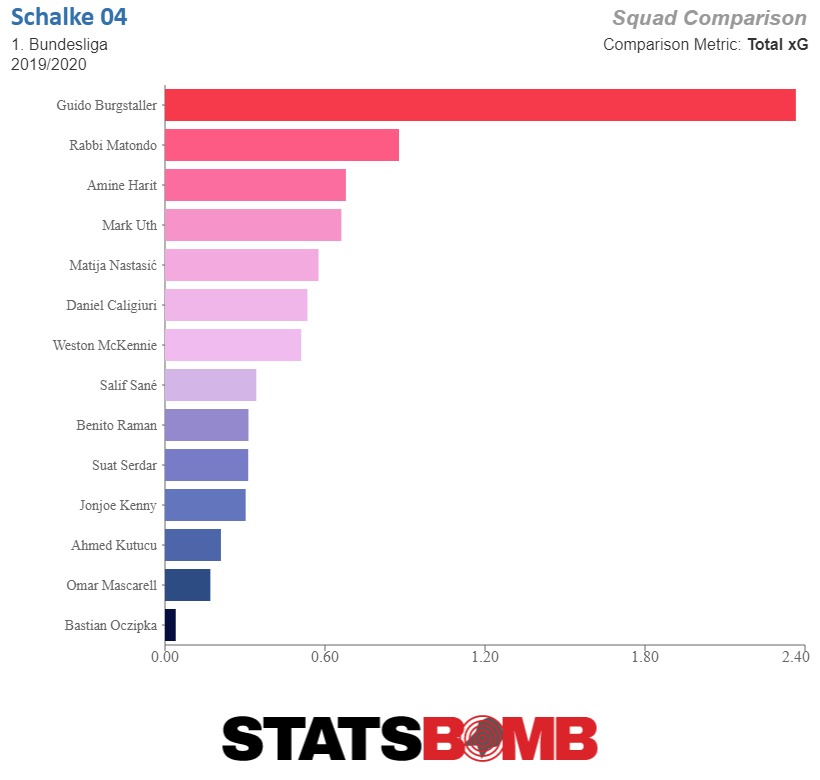 And this comes after last season where there was very little in the way of goal scoring threat anywhere on the squad.
And this comes after last season where there was very little in the way of goal scoring threat anywhere on the squad.  Wagner has shown some excellent tactical creativity by dusting off and playing little-used Rabbi Matondo at second striker. In what looked like a narrow 4-4-2, (perhaps a 4-3-1-2 with Harit behind the strikers), the Welshman’s pace gave their counters another dimension against Leipzig, and left Nagelsmann befuddled. Matondo walked away with five shots, a goal and 0.88 xG.
Wagner has shown some excellent tactical creativity by dusting off and playing little-used Rabbi Matondo at second striker. In what looked like a narrow 4-4-2, (perhaps a 4-3-1-2 with Harit behind the strikers), the Welshman’s pace gave their counters another dimension against Leipzig, and left Nagelsmann befuddled. Matondo walked away with five shots, a goal and 0.88 xG.  Still, given the attacking struggles though, it's no wonder the excellent fellas over at Schalkemerica have started the #freeKutucu movement, in an effort to play the 19-year-old Turkish striker, about whom Manchester City inquired in the summer. Behind the striker, Wagner has played former right back Daniel Caligiuri as a traditionally dribbling and pressing winger on the right, though his performances have not been great. On the left, there is Amine Harit, who can move into the ten spot, but also take Benito Raman’s spot as a creative inverted winger on the left. Aside from the aforementioned goals, creativity and dribbling, Harit is also a functional defensive contributor. Raise your hand, if you had Harit - the same player who was banned from a Duisburg casino in January for “his own good” - as a natural fit at winger for a team implementing an intense counterpressing system. At the ten/eight spots they alternate two incredibly dynamic and versatile players in Serdar and Weston McKennie, who is equally capable of pressing as a second striker, as he is at joining Mascarell in the double pivot. With that kind of organization, positional flexibility, intensity and athleticism, Schalke can hold a lot of teams for big spurts. That includes Bayern, who even tried a funky use of David Alaba as a false full back alongside the now regular number six Joshua Kimmich, but were for large portions of the game, unable to break through the Royal Blues pressing. https://twitter.com/BundesPL/status/1165929569460924416?s=20 And of course, Leipzig, whose XG flatlined after Nübel’s double save on Forsberg and Sabitzer in the 16th, with the Austrian shattering the crossbar a minute earlier.
Still, given the attacking struggles though, it's no wonder the excellent fellas over at Schalkemerica have started the #freeKutucu movement, in an effort to play the 19-year-old Turkish striker, about whom Manchester City inquired in the summer. Behind the striker, Wagner has played former right back Daniel Caligiuri as a traditionally dribbling and pressing winger on the right, though his performances have not been great. On the left, there is Amine Harit, who can move into the ten spot, but also take Benito Raman’s spot as a creative inverted winger on the left. Aside from the aforementioned goals, creativity and dribbling, Harit is also a functional defensive contributor. Raise your hand, if you had Harit - the same player who was banned from a Duisburg casino in January for “his own good” - as a natural fit at winger for a team implementing an intense counterpressing system. At the ten/eight spots they alternate two incredibly dynamic and versatile players in Serdar and Weston McKennie, who is equally capable of pressing as a second striker, as he is at joining Mascarell in the double pivot. With that kind of organization, positional flexibility, intensity and athleticism, Schalke can hold a lot of teams for big spurts. That includes Bayern, who even tried a funky use of David Alaba as a false full back alongside the now regular number six Joshua Kimmich, but were for large portions of the game, unable to break through the Royal Blues pressing. https://twitter.com/BundesPL/status/1165929569460924416?s=20 And of course, Leipzig, whose XG flatlined after Nübel’s double save on Forsberg and Sabitzer in the 16th, with the Austrian shattering the crossbar a minute earlier.  In terms of their attacking structure, Wagner plays with 2 center backs and when pressed by two strikers like against Paderborn, Omar Mascarell drops in between them. Yet, due to some structural issues (Serdar\McKennie don’t always get into proper receiving position) and particularly Salif Sané’s risk averse passing, their ball progression from the back, is still a work in progress. It consists mostly of Stambouli’s usually excellent long passes, or a hoofed ball under pressure by the goalkeeper, Alexander Nübel, which if Burgstaller is able to control or lay off can work, considering the athleticism of Harit/Raman/McKennie/Caligiuri/Serdar. Otherwise, Schalke aim to progress the ball through switches to free up one of the fullbacks who then plays a one two with the 8s\ and either bombs down the flank or finds Amine Harit to create something. Under Wagner, set pieces have reappeared as an integral part of the game plan, with three goals on 18 shots. That’s almost half of the 6 goals on 122 shots last season and one direct free kick goal on 18 tries. It’s not quite at the otherworldly 14 (!!) goals on 100 shots plus 2 direct free kicks in the silver medal season under Tedesco, but they're clearly getting results. The dynamic is somewhat complicated. Their set piece xG is not all that impressive, in fact at 0.25 per match it's the seventh lowest in the league.
In terms of their attacking structure, Wagner plays with 2 center backs and when pressed by two strikers like against Paderborn, Omar Mascarell drops in between them. Yet, due to some structural issues (Serdar\McKennie don’t always get into proper receiving position) and particularly Salif Sané’s risk averse passing, their ball progression from the back, is still a work in progress. It consists mostly of Stambouli’s usually excellent long passes, or a hoofed ball under pressure by the goalkeeper, Alexander Nübel, which if Burgstaller is able to control or lay off can work, considering the athleticism of Harit/Raman/McKennie/Caligiuri/Serdar. Otherwise, Schalke aim to progress the ball through switches to free up one of the fullbacks who then plays a one two with the 8s\ and either bombs down the flank or finds Amine Harit to create something. Under Wagner, set pieces have reappeared as an integral part of the game plan, with three goals on 18 shots. That’s almost half of the 6 goals on 122 shots last season and one direct free kick goal on 18 tries. It’s not quite at the otherworldly 14 (!!) goals on 100 shots plus 2 direct free kicks in the silver medal season under Tedesco, but they're clearly getting results. The dynamic is somewhat complicated. Their set piece xG is not all that impressive, in fact at 0.25 per match it's the seventh lowest in the league.  But that's mostly down to a lack of opportunities. The three shots per match they're averaging from set pieces is one of the lowest totals in the league. They team seems to do good set piece work when they have the chance to, they could just benefit from more chances.
But that's mostly down to a lack of opportunities. The three shots per match they're averaging from set pieces is one of the lowest totals in the league. They team seems to do good set piece work when they have the chance to, they could just benefit from more chances. 
Cooling the hype train with numbers
Amidst all the positivity, there is some cause to be cautious, though that word is not exactly a household item in the Gelsenkirchen area. There is the fact that before the Leipzig triumph, 3 victories came against Hertha Paderborn and Mainz, three of the four lowest ranked Bundesliga teams. The 3-0 over Hertha was with the help of two own goals and it took nearly 270 minutes for Jonjoe Kenny to finally score the first goal by an actual Schalke player. The numbers, albeit improved from a dismal last season that saw them way underperform, also should cool some of the Schalke hype: shots against is down from 13.26 to 12.5, a respectable seventh in the league and non-penalty xG against is down from 1.25 to 1.08. the fourth best Bundesliga mark. Pair that with a 1.31 xG per match tally on the attacking side of the ball and you get a 0.23 xG difference. That's good, but it's not third place good.  Still, thirteen points from six games is an amazing and unexpected haul considering they were without a point in their first five matches last year. The reality of this team falls somewhere between the two extremes of 14th and second place in the previous two campaigns. The good news from a Schalke perspective is that neither last year’s signing Mark Uth, nor the new ones in Raman and Kabak have added much. Before matchday six, the top three looked like Bayern, Leipzig and BVB in some order, but as Dortmund continue to be extremely worrying there are some other candidates: Leverkusen and Gladbach appear to be righting the ship after getting spanked by BVB and Leipzig and failing in Europe, while Wolfsburg shipped the fewest xG against (non-Bayern Munich division) Then, there is Schalke who could sneak in the back door despite having, in late August, a higher chance of being relegated than making the Champions Leagie, according to fivethirtyeight.com. With four of the next five against struggling Cologne, Hoffenheim, Augsburg and Düsseldorf their slow climb up the table just might become an all out sprint. Header image courtesy of the Press Association
Still, thirteen points from six games is an amazing and unexpected haul considering they were without a point in their first five matches last year. The reality of this team falls somewhere between the two extremes of 14th and second place in the previous two campaigns. The good news from a Schalke perspective is that neither last year’s signing Mark Uth, nor the new ones in Raman and Kabak have added much. Before matchday six, the top three looked like Bayern, Leipzig and BVB in some order, but as Dortmund continue to be extremely worrying there are some other candidates: Leverkusen and Gladbach appear to be righting the ship after getting spanked by BVB and Leipzig and failing in Europe, while Wolfsburg shipped the fewest xG against (non-Bayern Munich division) Then, there is Schalke who could sneak in the back door despite having, in late August, a higher chance of being relegated than making the Champions Leagie, according to fivethirtyeight.com. With four of the next five against struggling Cologne, Hoffenheim, Augsburg and Düsseldorf their slow climb up the table just might become an all out sprint. Header image courtesy of the Press Association



 The formation naturally lends itself to this approach given the lack of forwards available to press the centre backs but also the coverage it has in both central and wide areas. The three central midfielders work with cohesion to execute the press when the ball gets moved through the central channels, whilst the wide men are equally important in their contribution to locking down the flanks. Forest’s wingers are regularly seen doubling up with their full back in an effort to successfully turn possession over or at least force the opponent to play the ball backwards. Their defensive organisation is not only compelling to watch though, it also turns up some intriguing trends in the data. First of all, Forest are rock bottom in the Championship for Defensive Distance – the average distance from a team’s own goal that it performs defensive actions – with the scarcity with which they’ll defend from the front showing clearly in this metric. They perform defensive actions closer to their own goal than any other team in the league.
The formation naturally lends itself to this approach given the lack of forwards available to press the centre backs but also the coverage it has in both central and wide areas. The three central midfielders work with cohesion to execute the press when the ball gets moved through the central channels, whilst the wide men are equally important in their contribution to locking down the flanks. Forest’s wingers are regularly seen doubling up with their full back in an effort to successfully turn possession over or at least force the opponent to play the ball backwards. Their defensive organisation is not only compelling to watch though, it also turns up some intriguing trends in the data. First of all, Forest are rock bottom in the Championship for Defensive Distance – the average distance from a team’s own goal that it performs defensive actions – with the scarcity with which they’ll defend from the front showing clearly in this metric. They perform defensive actions closer to their own goal than any other team in the league. 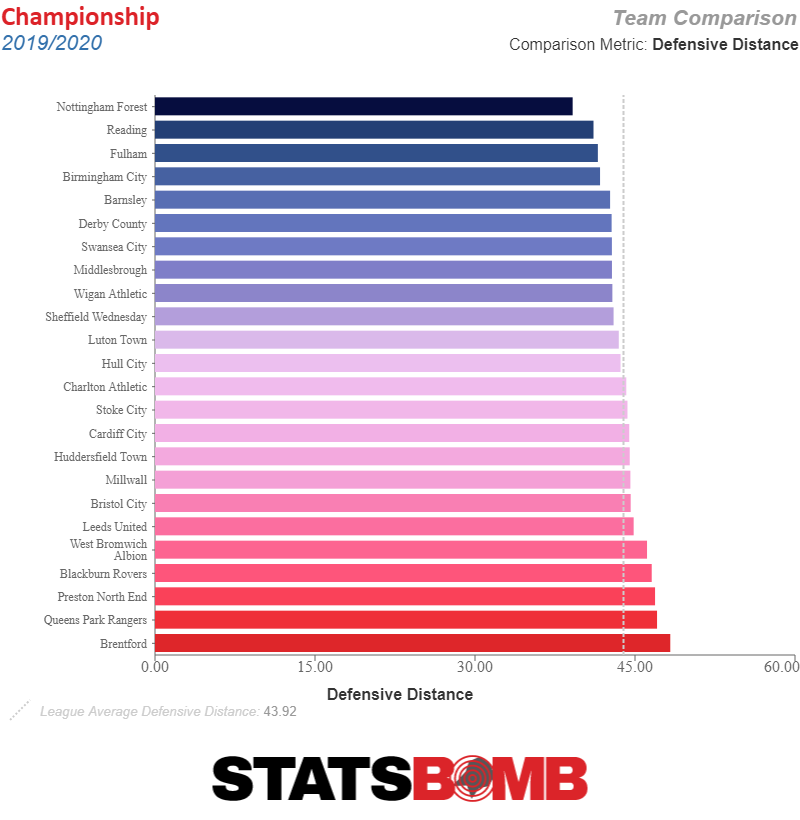 As you might expect of a side so keen to engage and disrupt the opposition when in their defensive third, Forest are also successfully limiting the quality of chances their opponents are able to create. They’re actually around mid-table for the amount of shots they’ve conceded so far – a shade over 12 per game – but the quality of those has been quelled and the average expected conversion rate of the chances they’re allowing is just seven percent, which is third best in their league. If we look at the distribution of those shots, we can see more clearly how they’ve kept this figure down. The Reds simply don’t concede clear cut chances. In eight games they’ve conceded a mere six opportunities that have an expected conversion rate of 20% or higher. If I remind you again that they’ve already played away at Leeds, whose
As you might expect of a side so keen to engage and disrupt the opposition when in their defensive third, Forest are also successfully limiting the quality of chances their opponents are able to create. They’re actually around mid-table for the amount of shots they’ve conceded so far – a shade over 12 per game – but the quality of those has been quelled and the average expected conversion rate of the chances they’re allowing is just seven percent, which is third best in their league. If we look at the distribution of those shots, we can see more clearly how they’ve kept this figure down. The Reds simply don’t concede clear cut chances. In eight games they’ve conceded a mere six opportunities that have an expected conversion rate of 20% or higher. If I remind you again that they’ve already played away at Leeds, whose  It sounds like management-speak to say that the star performer of Forest’s season so far has been the team, but it is largely true. Two of the more impressive individuals though have been in central midfield with Ben Watson, enjoying a late-career resurgence, receiving plaudits for his all-round game and intelligence in locking down the central area in front of his defence, and summer signing Samba Sow who’s really embodied what Lamouchi’s Reds are about. Sow, once he’s identified his target, has the defensive approach akin to that of a homing missile.
It sounds like management-speak to say that the star performer of Forest’s season so far has been the team, but it is largely true. Two of the more impressive individuals though have been in central midfield with Ben Watson, enjoying a late-career resurgence, receiving plaudits for his all-round game and intelligence in locking down the central area in front of his defence, and summer signing Samba Sow who’s really embodied what Lamouchi’s Reds are about. Sow, once he’s identified his target, has the defensive approach akin to that of a homing missile.  It’s clear that Forest’s best work comes when not in possession of the ball and their work in this area offers them a strong base to build from. What will be interesting is how well they can maintain their success if they continue to do well and start coming up against teams that are as happy to sit in as they are. They should be reassured that Lamouchi’s work on the training ground isn’t just limited to making them a cohesive unit without the ball as they’ve seemingly been putting the hours in to make them proficient at set plays too, a factor that could prove decisive in matches that are closely fought. Currently the Reds have created 0.36 xG per game from set play situations whilst conceding just 0.11 xG per game at the other end, figures that are both top four compared against their league rivals. Slightly less impressive is their output at the attacking end of the pitch, but it’s fair to argue that matters less when a) they’re keeping it locked down on the defensive end and b) they’ve had a tough schedule and Lamouchi isn’t a miracle worker. The amount of shots Forest take per game (a shade under 12) is much closer to league average and it’s a similar story with the amount of Expected Goals they’ve created, which is currently
It’s clear that Forest’s best work comes when not in possession of the ball and their work in this area offers them a strong base to build from. What will be interesting is how well they can maintain their success if they continue to do well and start coming up against teams that are as happy to sit in as they are. They should be reassured that Lamouchi’s work on the training ground isn’t just limited to making them a cohesive unit without the ball as they’ve seemingly been putting the hours in to make them proficient at set plays too, a factor that could prove decisive in matches that are closely fought. Currently the Reds have created 0.36 xG per game from set play situations whilst conceding just 0.11 xG per game at the other end, figures that are both top four compared against their league rivals. Slightly less impressive is their output at the attacking end of the pitch, but it’s fair to argue that matters less when a) they’re keeping it locked down on the defensive end and b) they’ve had a tough schedule and Lamouchi isn’t a miracle worker. The amount of shots Forest take per game (a shade under 12) is much closer to league average and it’s a similar story with the amount of Expected Goals they’ve created, which is currently  Watson works mostly in deeper areas but further forward it’s Joe Lolley, responsible for 22 combined goals and assists last season, who’s probably most important to Forest’s ability to get into the final third and in creating chances once they’re there, though the burden on him to produce decisive moments in the final third appears to have lessened this season. A member of England’s university and semi-professional teams before he made his breakthrough into the professional game, Lolley is constant in his desire to pick up the ball and drive up the right flank and has so far completed 87% of his dribbles and carries that end in the opposition half in his eight league appearances.
Watson works mostly in deeper areas but further forward it’s Joe Lolley, responsible for 22 combined goals and assists last season, who’s probably most important to Forest’s ability to get into the final third and in creating chances once they’re there, though the burden on him to produce decisive moments in the final third appears to have lessened this season. A member of England’s university and semi-professional teams before he made his breakthrough into the professional game, Lolley is constant in his desire to pick up the ball and drive up the right flank and has so far completed 87% of his dribbles and carries that end in the opposition half in his eight league appearances.  Experienced Championship campaigner Lewis Grabban has played every minute up front in the league and will be relied upon to provide clinical finishing to the end of Forest’s attacking moves if they’re to succeed this season, with their defensive base providing what should be a solid platform to pick results up from, if they maintain this level of performance. All in, it’s a promising start for the Tricky Trees with Sabri Lamouchi making a compelling early case to be the first manager for eight seasons to stay in the Forest managerial hotseat from season’s start to season’s end. But it’s top six or else.
Experienced Championship campaigner Lewis Grabban has played every minute up front in the league and will be relied upon to provide clinical finishing to the end of Forest’s attacking moves if they’re to succeed this season, with their defensive base providing what should be a solid platform to pick results up from, if they maintain this level of performance. All in, it’s a promising start for the Tricky Trees with Sabri Lamouchi making a compelling early case to be the first manager for eight seasons to stay in the Forest managerial hotseat from season’s start to season’s end. But it’s top six or else.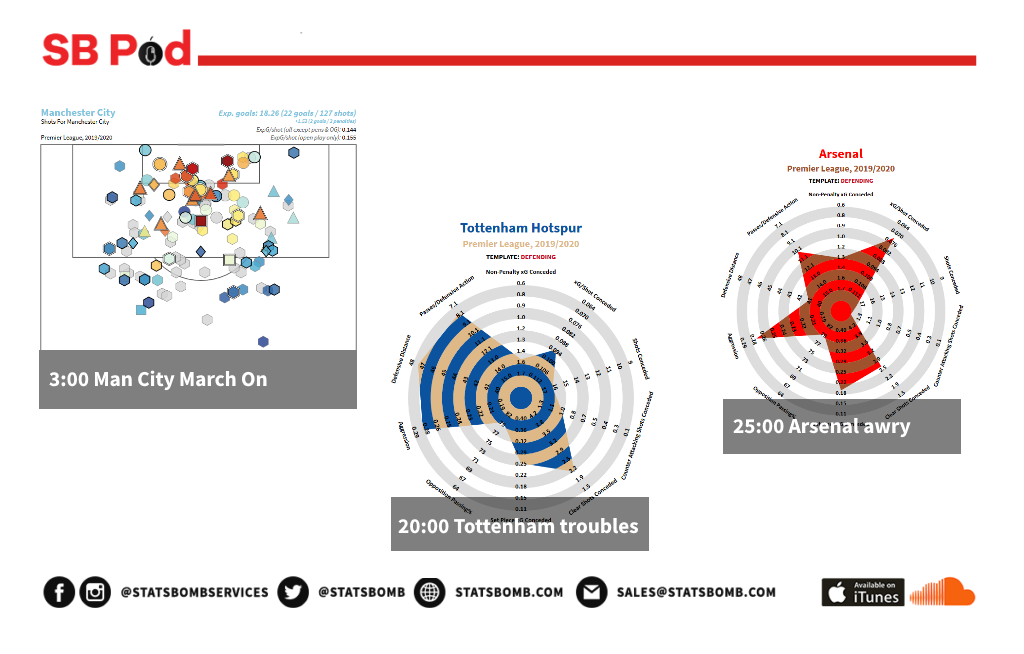

 That's the best mark in the league. If instead of raw numbers, we look at percentages, Steffen's 79.5% save percentage is 12.2% higher than expected given the profile of the shots on goal he's faced. That's the third highest gap in the league. Anyway you look at it, Steffen is playing his face off. It is at least worth noting, in the face of this amazing form, that during Steffen's last season at MLS his save % was actually lower by 5.1% than expectations. Düsseldorf, who deploy a fairly direct, counter-attacking playing style, are currently giving up a whopping total of 17,6 shots against per game, so Steffen will have a lot of opportunities to showcase his array of skills. The American shot-stopper’s main calling-card are his reflexes - Steffen could develop into one of Europe’s premier ‘line keepers’ - but he also impresses when the ball is at his feet, displaying pretty nifty ball-control and a really nice long ball. Steffen’s ‘floor’ seems to be a future wherein he is a very solid back-up for Ederson Moraes at Manchester City. But, if this form continues, he already seems to be a little too good to stand in someone else’s shadow, and only play in ten to 15 cup games a year.
That's the best mark in the league. If instead of raw numbers, we look at percentages, Steffen's 79.5% save percentage is 12.2% higher than expected given the profile of the shots on goal he's faced. That's the third highest gap in the league. Anyway you look at it, Steffen is playing his face off. It is at least worth noting, in the face of this amazing form, that during Steffen's last season at MLS his save % was actually lower by 5.1% than expectations. Düsseldorf, who deploy a fairly direct, counter-attacking playing style, are currently giving up a whopping total of 17,6 shots against per game, so Steffen will have a lot of opportunities to showcase his array of skills. The American shot-stopper’s main calling-card are his reflexes - Steffen could develop into one of Europe’s premier ‘line keepers’ - but he also impresses when the ball is at his feet, displaying pretty nifty ball-control and a really nice long ball. Steffen’s ‘floor’ seems to be a future wherein he is a very solid back-up for Ederson Moraes at Manchester City. But, if this form continues, he already seems to be a little too good to stand in someone else’s shadow, and only play in ten to 15 cup games a year.  The arrival of former Huddersfield Town manager David Wagner in Gelsenkirchen has revived Harit’s play. Wagner’s switch in playing system - the 5-3-2 formation of the past two seasons has been replaced by a more traditional 4-2-3-1 - and bigger roles in midfield for the talented Suat Serdar and the ever-energetic Omar Mascarell, have had a really positive effect on Harit, who plays as an inverted winger on the left side. In six competitive games for Schalke this year, Harit has already scored three goals - including a very juicy side-footed game-winner from distance last weekend (2-1 against Mainz) - tallied two assists, and won a penalty.
The arrival of former Huddersfield Town manager David Wagner in Gelsenkirchen has revived Harit’s play. Wagner’s switch in playing system - the 5-3-2 formation of the past two seasons has been replaced by a more traditional 4-2-3-1 - and bigger roles in midfield for the talented Suat Serdar and the ever-energetic Omar Mascarell, have had a really positive effect on Harit, who plays as an inverted winger on the left side. In six competitive games for Schalke this year, Harit has already scored three goals - including a very juicy side-footed game-winner from distance last weekend (2-1 against Mainz) - tallied two assists, and won a penalty.  Clearly Harit is benefiting from a finishing hot streak, but if we take one step back and look at his dribbling we see where he really shines. Only Jadon Sancho and Leon Bailey are averaging more completed dribbles per 90 minutes (out of players who have played more than 200 minutes) after five Bundesliga games than Harit's 3.90. And, as we can see from this map of all his carries, he's a frequent and secure mover with the ball at his feet.
Clearly Harit is benefiting from a finishing hot streak, but if we take one step back and look at his dribbling we see where he really shines. Only Jadon Sancho and Leon Bailey are averaging more completed dribbles per 90 minutes (out of players who have played more than 200 minutes) after five Bundesliga games than Harit's 3.90. And, as we can see from this map of all his carries, he's a frequent and secure mover with the ball at his feet. 
 The Portuguese striker is a clinical finisher, a strong aerial presence, and surprisingly calm and smart as a passer.
The Portuguese striker is a clinical finisher, a strong aerial presence, and surprisingly calm and smart as a passer.  While his goal scoring is a little ahead of his xG, of 0.43 per 90 minutes is perfectly respectable. And, also pretty important when playing for a Bundesliga club, he works his ass off in pressing the opposing build-up all over the pitch.
While his goal scoring is a little ahead of his xG, of 0.43 per 90 minutes is perfectly respectable. And, also pretty important when playing for a Bundesliga club, he works his ass off in pressing the opposing build-up all over the pitch.  Frankfurt bought Paciência last summer at a bargain price, as well. FC Porto agreed to a transfer fee of 3 million euros. Paciência, who has scored three and assisted one in both the Bundesliga and Europa League this season, will make Frankfurt another fortune in the near future. The recent recruitment successes of Die Adler with sporting director Fredi Bobic at the helm will have a strengthening effect on the club in the long term. In the short term, they are mostly felt in the form of loads of goals by strikers bought on the cheap.
Frankfurt bought Paciência last summer at a bargain price, as well. FC Porto agreed to a transfer fee of 3 million euros. Paciência, who has scored three and assisted one in both the Bundesliga and Europa League this season, will make Frankfurt another fortune in the near future. The recent recruitment successes of Die Adler with sporting director Fredi Bobic at the helm will have a strengthening effect on the club in the long term. In the short term, they are mostly felt in the form of loads of goals by strikers bought on the cheap.







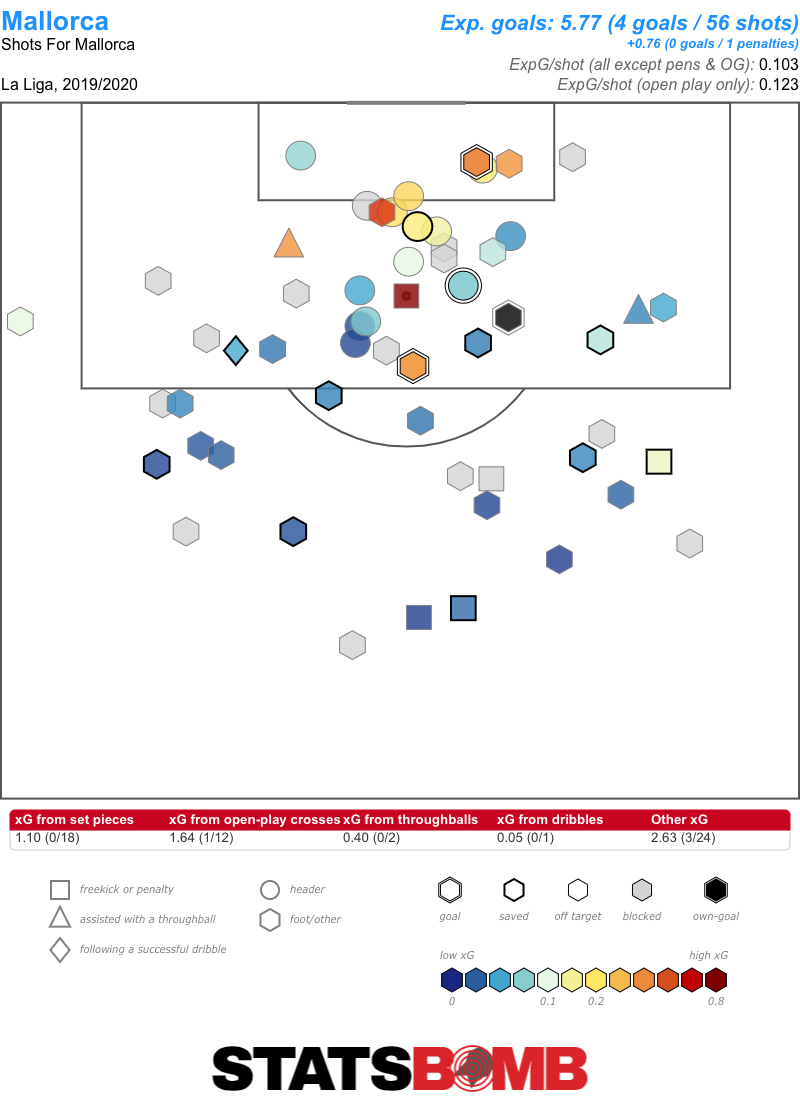




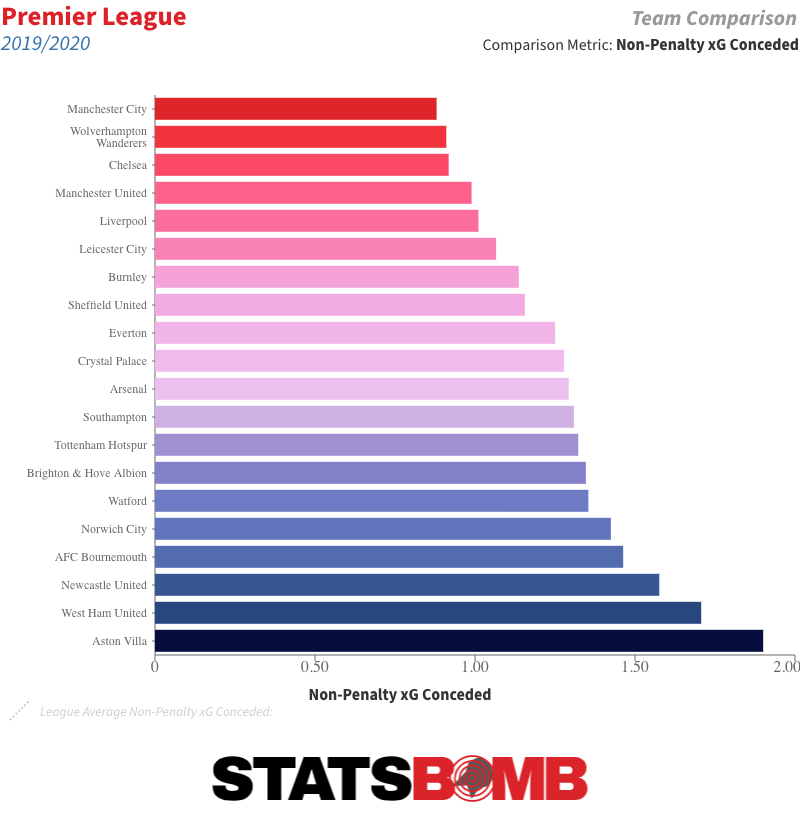





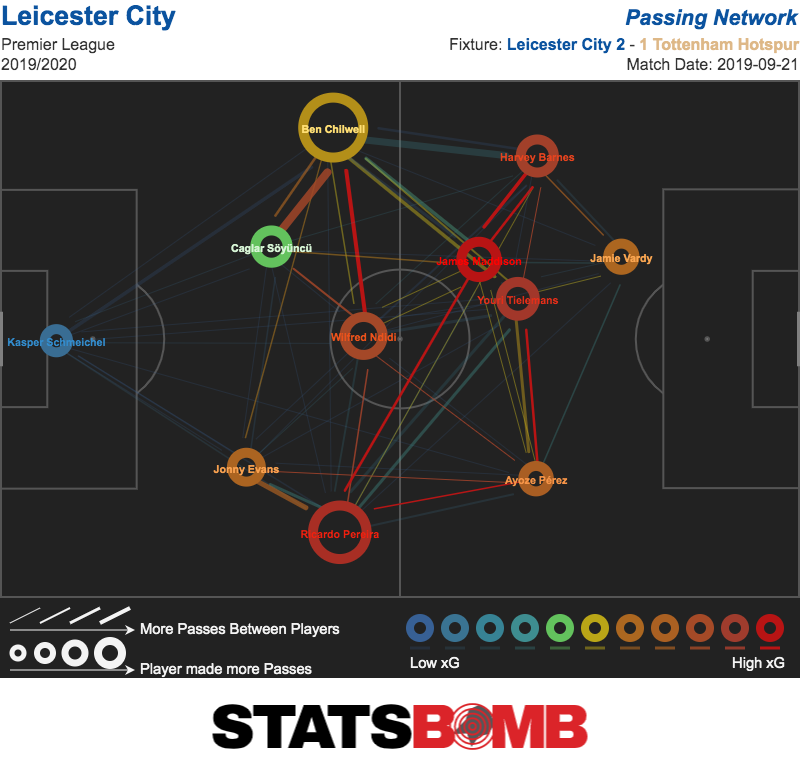
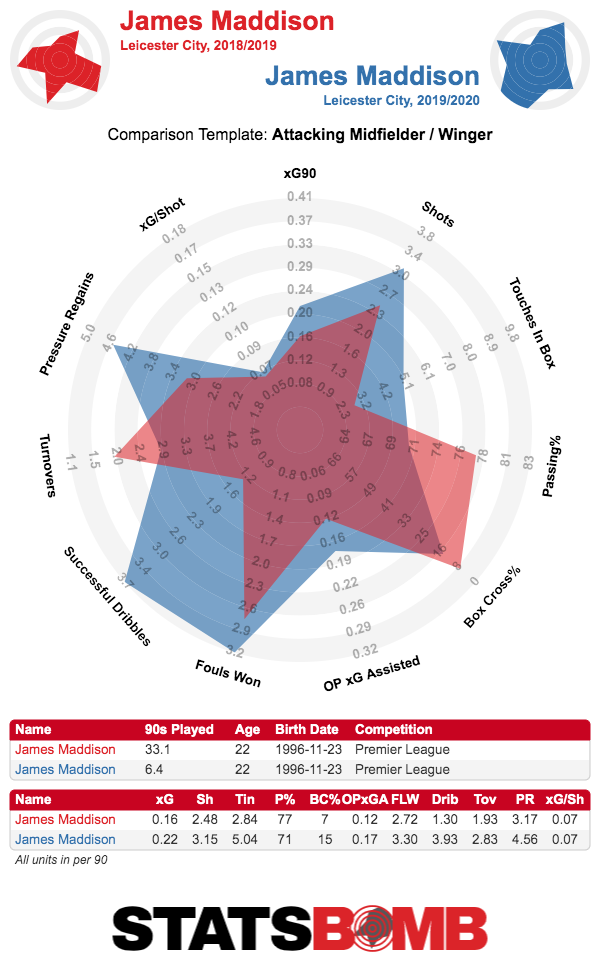







 On the defensive side of the ball is where the good news is. Sure they’ve given up 11 goals, but only 6.49 expected goals. That’s exactly the kind of performance you’d expect to see turn around without doing too much of anything different.
On the defensive side of the ball is where the good news is. Sure they’ve given up 11 goals, but only 6.49 expected goals. That’s exactly the kind of performance you’d expect to see turn around without doing too much of anything different.  Specifically all of that extra conceding seems like it’s down mostly to keeper So far this season he has the worst goals saved above average % of any regular starting keeper in the Premier League. He’s only saved 50% of the shots he’s faced while his expected average giving those shots is 66.1%. That’s really bad! Patricio’s -16.1 GSAA% is significantly behind Everton’s Jordan Pickford at -9.9% and Chelsea’s Kepa Arrizabalaga’s -9.1%.
Specifically all of that extra conceding seems like it’s down mostly to keeper So far this season he has the worst goals saved above average % of any regular starting keeper in the Premier League. He’s only saved 50% of the shots he’s faced while his expected average giving those shots is 66.1%. That’s really bad! Patricio’s -16.1 GSAA% is significantly behind Everton’s Jordan Pickford at -9.9% and Chelsea’s Kepa Arrizabalaga’s -9.1%.  Encouragingly for Wolves, last year Patricio’s was almost exactly flat against expectation. He saved 71% of shots and was expected to save 71.1%. So this horrible form will probably work itself out. They don’t need him to be great this season, they just need him to be fine. So far, he hasn’t been, but there’s not a ton of reason to suspect he won’t be going forward. So that’s the good news. Here’s the bad news. Even adjusting for the unexpected defensive lapses, Wolves haven’t been nearly as good as last season. Last season StatsBomb had their xG difference at 0.28 per match, virtually tied with Spurs for the fourth best in the Premier League. This season, so far it’s dropped to -0.16. That’s not nearly bad enough to be where they are in the table, but it’s not in any way remarkable. It’s just outside the top half of the table (and interestingly enough again virtually tied with Spurs). That difference amounts to almost half a goal per match, or just under three goals in six games. For a team that’s drawn four times and lost another match by a single goal, that’s a massive difference. Their sixth match, a 2-5 home defeat to Chelsea was one of the wilder mostly balanced xG matches you will find.
Encouragingly for Wolves, last year Patricio’s was almost exactly flat against expectation. He saved 71% of shots and was expected to save 71.1%. So this horrible form will probably work itself out. They don’t need him to be great this season, they just need him to be fine. So far, he hasn’t been, but there’s not a ton of reason to suspect he won’t be going forward. So that’s the good news. Here’s the bad news. Even adjusting for the unexpected defensive lapses, Wolves haven’t been nearly as good as last season. Last season StatsBomb had their xG difference at 0.28 per match, virtually tied with Spurs for the fourth best in the Premier League. This season, so far it’s dropped to -0.16. That’s not nearly bad enough to be where they are in the table, but it’s not in any way remarkable. It’s just outside the top half of the table (and interestingly enough again virtually tied with Spurs). That difference amounts to almost half a goal per match, or just under three goals in six games. For a team that’s drawn four times and lost another match by a single goal, that’s a massive difference. Their sixth match, a 2-5 home defeat to Chelsea was one of the wilder mostly balanced xG matches you will find. 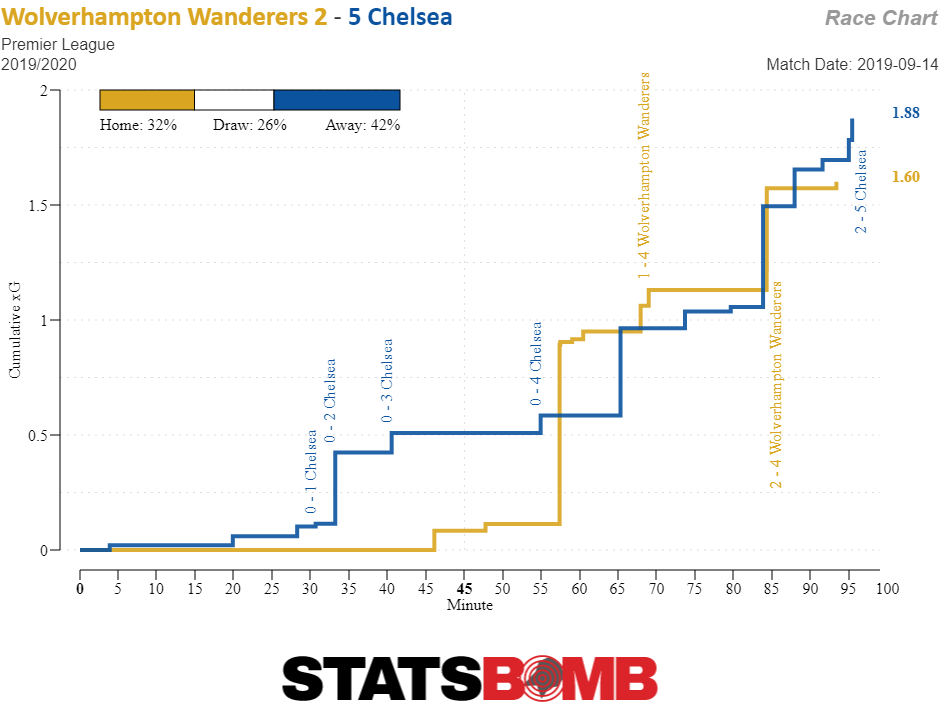 Last season Wolves were a great defensive team. They were one of only four teams to concede fewer than one xG per match (0.91). They were also a decent attacking side. They accumulated 1.19 xG per match, which is nothing to write home about but landed them exactly in the middle of the league. This year they’re just worse on both sides of the ball. This year their defense is average, at 1.09 xG conceded, which trails eight other teams and their attack, well their attack at 0.92 xG per match is simply an utter mess.
Last season Wolves were a great defensive team. They were one of only four teams to concede fewer than one xG per match (0.91). They were also a decent attacking side. They accumulated 1.19 xG per match, which is nothing to write home about but landed them exactly in the middle of the league. This year they’re just worse on both sides of the ball. This year their defense is average, at 1.09 xG conceded, which trails eight other teams and their attack, well their attack at 0.92 xG per match is simply an utter mess.  Then there’s a matter of the schedule. They’ve played a relatively difficult set of six games so far, facing Leicester City away, Manchester United at home and Chelsea at home. Though given the sides early season aspirations those were all games they’d be expected to compete in and taking only two points is minorly disappointing. That said, if they’d taken more than two points from Burnley at home, Everton away, and Palace away nobody would have much noticed the struggles against the top teams. If Wolves had taken six points from the easy half of their schedule they’d currently be tied with the six teams sitting in seventh through 12th place. Instead they’re beginning a fledgling fight against relegation. The next month remains pretty easy for Wolves. Before the end of October the side will face fellow relegation battlers Watford at home and Newcastle away, as well as hosting Southampton (currently in 13th place). Just ignore that they fourth match in that stretch of time is against Manchester City. It’s possible that with a handful of strong performances Wolves numbers will improve, and their results will follow (especially if that is combined with their luck turning). Another month of struggling though, and the discussion slips from having a minorly disappointing season to a real relegation battle. There are, as there always are, all sorts of possible reasons for the poor start. There’s the added burden of Europa League, especially on a squad that was fairly short to begin with and didn’t add much depth this summer. Even minor rotation for a team exceptionally used to a fixed starting 11 can be disruptive. Wolves have been starting bit players from last year like Morgan Gibbs-White and giving super sub Adama Traoré starts at wingback. It’s also possible their numbers are being impacted by playing from behind so much. They’ve conceded first in five of their six matches (and the sixth was the 0-0 opening day draw against Leicester). For a team built to defend, the fact that they’ve been forced to chase the game so often might be dragging their numbers down (one might for example imagine a world where they have improved numbers because several of their draws came from late, lucky equalizers rather than what actually happened where they scored late themselves). This again is the kind of factor that generally, although not always, evens itself out as the season progresses. The bottom line for Wolves is that there is no reason to panic. The team’s defense is its calling card, and that defense has been pretty unlucky so far this season. It will likely improve as the season goes on, just by dint of getting out from whatever soccer god cloud is currently raining goals on them nonstop. That should be enough to turn them into a somewhat below average team that’s safe from relegation. After last year, however, that shouldn’t be enough for Wolves. This side was genuinely impressive last season, and they’ve come out of the gate this year looking genuinely average. Whether it’s Europa League or something else, Wolves have taken a step backwards. The fact that it won’t likely cost them relegation doesn’t mean it shouldn’t be disappointing. This was a team on a meteoric trajectory. Without some sharp improvements over the next month, they’re now overwhelmingly likely to be just another midtable side.
Then there’s a matter of the schedule. They’ve played a relatively difficult set of six games so far, facing Leicester City away, Manchester United at home and Chelsea at home. Though given the sides early season aspirations those were all games they’d be expected to compete in and taking only two points is minorly disappointing. That said, if they’d taken more than two points from Burnley at home, Everton away, and Palace away nobody would have much noticed the struggles against the top teams. If Wolves had taken six points from the easy half of their schedule they’d currently be tied with the six teams sitting in seventh through 12th place. Instead they’re beginning a fledgling fight against relegation. The next month remains pretty easy for Wolves. Before the end of October the side will face fellow relegation battlers Watford at home and Newcastle away, as well as hosting Southampton (currently in 13th place). Just ignore that they fourth match in that stretch of time is against Manchester City. It’s possible that with a handful of strong performances Wolves numbers will improve, and their results will follow (especially if that is combined with their luck turning). Another month of struggling though, and the discussion slips from having a minorly disappointing season to a real relegation battle. There are, as there always are, all sorts of possible reasons for the poor start. There’s the added burden of Europa League, especially on a squad that was fairly short to begin with and didn’t add much depth this summer. Even minor rotation for a team exceptionally used to a fixed starting 11 can be disruptive. Wolves have been starting bit players from last year like Morgan Gibbs-White and giving super sub Adama Traoré starts at wingback. It’s also possible their numbers are being impacted by playing from behind so much. They’ve conceded first in five of their six matches (and the sixth was the 0-0 opening day draw against Leicester). For a team built to defend, the fact that they’ve been forced to chase the game so often might be dragging their numbers down (one might for example imagine a world where they have improved numbers because several of their draws came from late, lucky equalizers rather than what actually happened where they scored late themselves). This again is the kind of factor that generally, although not always, evens itself out as the season progresses. The bottom line for Wolves is that there is no reason to panic. The team’s defense is its calling card, and that defense has been pretty unlucky so far this season. It will likely improve as the season goes on, just by dint of getting out from whatever soccer god cloud is currently raining goals on them nonstop. That should be enough to turn them into a somewhat below average team that’s safe from relegation. After last year, however, that shouldn’t be enough for Wolves. This side was genuinely impressive last season, and they’ve come out of the gate this year looking genuinely average. Whether it’s Europa League or something else, Wolves have taken a step backwards. The fact that it won’t likely cost them relegation doesn’t mean it shouldn’t be disappointing. This was a team on a meteoric trajectory. Without some sharp improvements over the next month, they’re now overwhelmingly likely to be just another midtable side.








